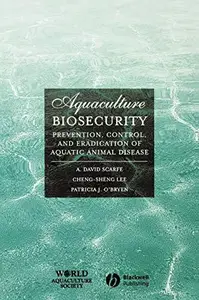
Free Download Aquaculture Biosecurity: Prevention, Control, and Eradication of Aquatic Animal Disease By
2006 | 187 Pages | ISBN: 0813805392 | PDF | 2 MB
Published in Cooperation with THE WORLD AQUACULTURE SOCIETY Aquaculture loses millions of dollars in revenue annually due to aquatic animal diseases. Disease outbreaks continue to threaten profitable and viable aquaculture operations throughout the world. As a result, aquaculture biosecurity programs that address aquatic animal pathogens and diseases have become an important focus for the aquaculture industry. Aquaculture Biosecurity: Prevention, Control, and Eradication of Aquatic Animal Disease provides valuable information that will increase success in combating infectious aquatic disease. Key representatives of international, regional, and national organizations presented their views on this important issue as part of a special session at the 2004 World Aquaculture Society Annual Conference. The chapters of this book cover a wealth of experience from the varied perspectives of these experts on biosecurity, policies, and measures to take the offensive against the spread of diseases in aquatic animals. With contributions from renowned international experts, covering approaches to biosecurity policies and measures currently practiced, Aquaculture Biosecurity: Prevention, Control, and Eradication of Aquatic Animal Disease is a vital reference for all those concerned about protecting aquaculture from impacts of aquatic animal disease.Content: Chapter 1 Aquaculture Biosecurity: The View and Approaches of the OIE (World Organisation for Animal Health) Regarding Prevention and Control of Aquatic Animal Diseases (pages 3-8): Eva?Maria BernothChapter 2 Biosecurity in Aquaculture: International Agreements and Instruments, Their Compliance, Prospects, and Challenges for Developing Countries (pages 9-16): Rohana P. Subasinghe and Melba G. Bondad?ReantasoChapter 3 Regional Approach to Aquatic Animal Health Management?Views and Programs of the Network of Aquaculture Centres in Asia-Pacific (pages 17-29): C.V. Mohan and Melba G. Bondad-ReantasoChapter 4 Canada's Approach to Aquatic Animal Biosecurity: Experience and Evolution (pages 31-54): Sharon E. McGladdery and Richard E. ZurbriggChapter 5 The U.S. Fish & Wildlife Service's "Aquatic Animal Health Policy": Innovative Approaches to Managing Diseases in Traditional and Special-Case Aquatic Animals (pages 55-67): Thomas A. Bell, J. Scott Foott, Kathy Clemens, Susan Gutenberger, Ray Brunson, John Thoesen, Rick Nelson, Norm Heil, John Coll and Crystal HudsonChapter 6 Wisconsin's Veterinary Approach to Fish Health (pages 69-76): Myron J. KebusChapter 7 Harmonized, Standardized, and Flexible National Frameworks for Ensuring Diagnostic Data and Test Result Validity: A Critical Need for Aquatic Animal Health Diagnostic Systems and for Biosecurity in Aquaculture (pages 77-89): Ann L. Wiegers, Jerry R. Heidel and A. David ScarfeChapter 8 Disinfectants, Disinfection, and Biosecurity in Aquaculture (pages 91-128): G. Russell Danner and Peter MerrillChapter 9 Aquatic Animal Health Surveillance (pages 129-148): F. Chris Baldock, Angus R. Cameron and Nigel R. PerkinsChapter 10 Biosecurity at the Farm Level-How to Create a State of Mind (pages 149-154): Paul Hardy?SmithChapter 11 Elements of an Aquatic Animal Health Program?Infectious Hematopoietic Necrosis in Farmed Atlantic Salmon in British Columbia (pages 155-163): Grace A. KarremanChapter 12 A Preliminary Investigation of the Relationship Between Infected Cage Removal Speed and Resultant Spread of Infectious Salmon Anemia on Atlantic Salmon Farms in Maine, U.S.A., and New Brunswick, Canada (pages 165-172): Lori Gustafson, Stephen Ellis, Leighanne Hawkins, Mark Moore, Teresa Robinson and Dan MacPhee
Code:
Bitte
Anmelden
oder
Registrieren
um Code Inhalt zu sehen!